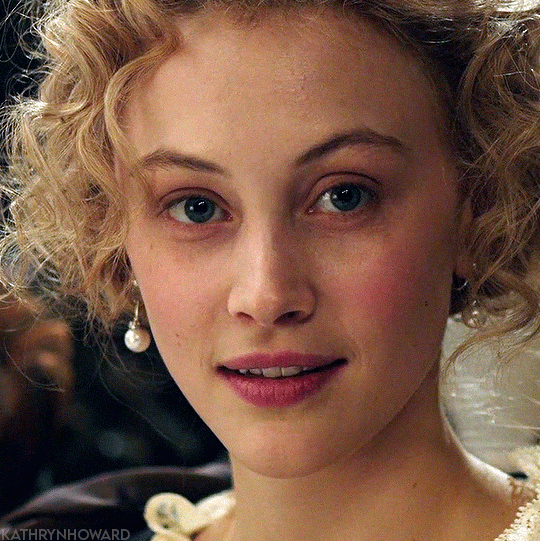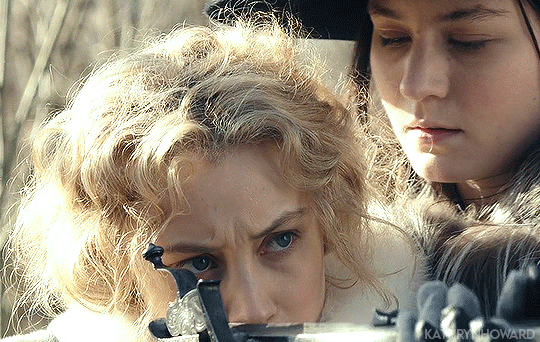#Ebba Sparre
Explore tagged Tumblr posts
Text







Queen Christina of Sweden and her Lady-In-Waiting Ebba Sparre
"Most of Christina's free time was spent in the company of Ebba Larsdotter Sparre, nicknamed by the queen herself as 'la belle comtesse', and she often drew attention to her friend's beauty. She introduced her to the English ambassador Whitelocke as his bedmate, claiming that Sparre's intellect was as extraordinary as the beauty of her body. When Christina left Sweden she continued writing passionate love letters to Sparre, telling her that she would always be her lover."
#christina of sweden#ebba sparre#greta garbo#elizabeth young#queen christina#rouben mamoulian#1933#classic film#classic hollywood#old hollywood#caps
276 notes
·
View notes
Photo


SARAH GADON as COUNTESS EBBA SPARRE THE GIRL KING (2015)
#perioddramaedit#periodgif#periodedit#thegirlkingedit#The Girl King#sgadonedit#sarahgadonedit#Sarah Gadon#Ebba Sparre#*mine
328 notes
·
View notes
Text
Queer history fact: Ordinari Post Tijdender ("Regular Mail Times"), founded in 1645 continues today as the world's longest-running newspaper and was started by Kristina King of Sweden.
King Kristina was initially assigned male at birth though this was amended to female a couple of days later. They had a female lover named Ebba Sparre, and for a period of their life, they went under the name Kristine Alexandre. Unquestionably queer, the possible modern labels they may have fallen under include demisexual, lesbian, transgender, nonbinary, and intersex!
#queer history#queer#lgbt#lgbt history#gay history#lesbian history#transgender history#transgender#making queer history
836 notes
·
View notes
Text


Sarah Gadon as Countess Ebba Sparre in The Girl King (2015)
92 notes
·
View notes
Text
THIS DAY IN GAY HISTORY
based on: The White Crane Institute's 'Gay Wisdom', Gay Birthdays, Gay For Today, Famous GLBT, glbt-Gay Encylopedia, Today in Gay History, Wikipedia, and more … December 19



1626 – Queen Christina of Sweden (d.1689), Queen regnant of Swedes, Goths and Vandals, Grand Princess of Finland, and Duchess of Ingria, Estonia, Livonia and Karelia, from 1633 to 1654. She was the only surviving legitimate child of King Gustav II Adolph and his wife Maria Eleonora of Brandenburg. As the heiress presumptive, at the age of six she succeeded her father on the throne of Sweden upon his death at the Battle of Lützen. Being the daughter of a Protestant champion in the Thirty Years' War, she caused a scandal when she abdicated her throne and converted to Catholicism in 1654. She spent her later years in Rome, becoming a leader of the theatrical and musical life there. As a queen without a country, she protected many artists and projects. She is one of the few women buried in the Vatican grotto.
Christina was moody, intelligent, and interested in books and manuscripts, religion, alchemy and science. She wanted Stockholm to become the Athens of the North. Influenced by the Counter Reformation, she was increasingly attracted to the Baroque and Mediterranean culture that took her away from her Protestant country. Her unconventional lifestyle and masculine behaviour would feature in countless novels and plays, and in opera and film. In the twentieth century, Christina became a symbol of cross-dressing, transsexuality and lesbianism.
Christina was unusual in her own time for choosing masculine dress, and she also had some masculine physical features. Whether she choose her attire because of a self-perception as masculine, or purely for reasons of functional convenience, is difficult to know.
She was irrefutably gender-variant, cross-dressing by her early teens. Of Queen Christina, Father Marmerschied, priest to the Spanish Ambassador, remarked, "There is nothing feminine about her except her sex. Her voice, her walk, her style, her ways are all quite masculine."Christina associated mostly with men, letting go of the ladies-in-waiting routine. But there was one particular romantic relationship she'd had since her teens. The Queen did not hide her affectionate bond to her best female friend and noted passion of her youth, Ebba Sparre, whom she called Belle. Most of her spare time was spent with 'la belle comtesse' - and she often called attention to her beauty. She introduced her to the English ambassador Whitelocke as her 'bed-fellow', assuring him that Sparre's intellect was as striking as her body. Queen Christina wrote to her, "and if you remember the power you have over me, you will also remember I have been in possession of your love for twelve years; I belong to you so utterly, that it will never be possible for you to lose me; and only, when I die, shall I cease loving you."
Christina abdicated her throne on 5 June 1654, in favor of her cousin Charles Gustavus, amid some financial hanky panky and wandered Europe, dressed as a man, frequently under the pseudonym of Count Dohna.
Based on historical accounts of Christina's physicality, some scholars believe her to have been an intersexed individual. (Someone with a blend of female and male genitals, hormones, or chromosomes.)
According to Christina's autobiography, the midwives at her birth first believed her to be a boy because she was "completely hairy and had a coarse and strong voice." After changing their minds, deciding that she was female, her father Gustav II Adolph decided "to find out for himself the nature of the matter."
Such ambiguity did not end with birth, as Christina made cryptic statements about her "constitution" and body throughout life. Her unusual body was also noted by acquaintances, who noted that the queen had a masculine voice, appearance, and movements. Although not direct evidence of her bodily makeup, Christina had a disdain for marriage, sex, and childrearing that may have stemmed from the realities of such things for a person of unusual physicality.
In 1965 all of these observations led to an investigation of Christina's mortal remains, which had inconclusive results. As the physical anthropologist who undertook the investigation, Carl-Herman Hjortsjö, explained, "Our imperfect knowledge concerning the effect of intersexuality on the skeletal formation ... makes it impossible to decide which positive skeletal findings should be demanded upon which to base the diagnosis of intersexuality." Nevertheless, Hjortsjö speculated that Christina had reasonably typical female genitalia because it is recorded that she menstruated.


1904 – On this date the female impersonator extraordinaire Barbette was born (d.1973). Born Vander Clyde in Round Rock, Texas, Clyde achieved international fame as Barbette, a female impersonator and trapeze and high-wire performer. Enamored of the circus after his mother took him to his first performance in Austin, Clyde began practicing on the clothesline in his mother's yard and working in the fields for money to go to as many circuses as possible. After graduating from high school at age fourteen, he traveled to San Antonio to answer a Billboard advertisement placed by one of the Alfaretta Sisters, "World Famous Aerial Queens." He joined the act on the condition that he dress as a girl, since his partner believed that women's clothes made a wire act more dramatic. He later performed in Erford's Whirling Sensation, in which he and two others hung by their teeth from a revolving apparatus.
During this period Clyde began developing a solo act in which he appeared and performed as a woman and removed his wig to reveal his masculinity at the end of the performance. After adopting the name Barbette, he traveled throughout the United States performing the act, which became wildly popular. In the fall of 1923 the William Morris Agency sent him to England and then to Paris, where he opened at the Alhambra Music Hall. Barbette became the talk of Paris and was befriended by members of both American café society and French literary and social circles.
In particular, his artistry was championed by French poet and dramatist Jean Cocteau. Inspired by Barbette's act, which he described as "an extraordinary lesson in theatrical professionalism," Cocteau wrote a review in the July 1926 issue of the Nouvelle Revue Française, "Le Numéro Barbette," which is considered a classic essay on the nature of art. As described by Cocteau, Barbette's acrobatics became a vehicle for theatrical illusion. From his entrance, when he appeared in an elaborate ball gown and an ostrich-feather hat, to an elaborate striptease down to tights and leotard in the middle of the act, Barbette enacted a feminine allure that was maintained despite the vigorous muscular activity required by his trapeze routine. Only at the end of the performance, when he removed his wig, did he dispel the illusion, at which time he mugged and flexed in a masculine manner to emphasize the success of his earlier deception. To Cocteau, Barbette's craftsmanship, practiced on the fine edge of danger, elevated a rather dubious stunt to the level of art, analogous to the struggle of a poet.
Cocteau wrote about Barbette on several other occasions, and in 1930 he used the aerialist in his first film, Le Sang d'un Poete (Blood of a Poet), in which the bejeweled and Chanel-clad Barbette and other aristocrats applauded a card game that ends in suicide.


1910 – Jean Genet (d.1986) was a prominent and controversial French novelist, playwright, poet, essayist, and political activist. Early in his life he was a vagabond and petty criminal, but later took to writing. His major works include the novels Querelle of Brest, The Thief's Journal, and Our Lady of the Flowers, and the plays The Balcony, The Blacks, The Maids and The Screens. He is the author of the quote: "I'm homosexual... How and why are idle questions. It's a little like wanting to know why my eyes are green."
While he received excellent grades in school, his childhood involved a series of attempts at running away and incidents of petty theft . For this and other misdemeanors, including repeated acts of vagrancy, he was sent at the age of 15 to Mettray Penal Colony from 1926 to 1929. In The Miracle of the Rose (1946), he gives an account of this period of detention, which ended at the age of 18 when he joined the Foreign Legion. He was eventually given a dishonorable discharge on grounds of indecency (having been caught engaged in a homosexual act) and spent a period as a vagabond, petty thief and prostitute across Europe— experiences he recounts in The Thief's Journal (1949).
After returning to Paris, France in 1937, Genet was in and out of prison through a series of arrests for theft, use of false papers, vagabondage, lewd acts and other offenses. In prison, Genet wrote his first poem, "Le condamné à mort," which he had printed at his own cost, and the novel Our Lady of the Flowers (1944). In Paris, Genet sought out and introduced himself to Jean Cocteau, who was impressed by his writing. Cocteau used his contacts to get Genet's novel published, and in 1949, when Genet was threatened with a life sentence after ten convictions, Cocteau and other prominent figures, including Jean-Paul Sartre and Pablo Picasso, successfully petitioned the French President to have the sentence set aside. Genet would never return to prison.
By 1949 Genet had completed five novels, three plays and numerous poems. His explicit and often deliberately provocative portrayal of homosexuality and criminality was such that by the early 1950s his work was banned in the United States.
In the 60s and 70s he became highly politically active in France, the USA, and the Middle East. Genet developed throat cancer and was found dead on April 15, 1986 in a hotel room in Paris. Genet may have fallen on the floor and fatally hit his head.


1957 – Cyril Collard (d.1993) was a French author, filmmaker, composer, musician and actor. He is known for his unapologetic portrayals of bisexuality and HIV in art, particularly his autobiographical novel and film Les Nuits Fauves (Savage Nights). Openly bisexual, Collard was also one of the first French artists to speak openly about his HIV-positive status.

The semi-autobiographical Savage Nights (Les Nuits Fauves), finished in 1992, was Collard's first and only feature film. The autobiographical story examines the life of a thirtyish aspiring director, Jean, engaged in simultaneous affairs with an 18-year-old French girl and a young, "straight" Spanish rugby player, Samy, who develops a taste for S&M and moves in with him, while Jean still (compulsively?) enjoys frequent, rough anonymous hookups, all of which is further complicated by his being HIV+. It won four Césars (best editing, best film, best first work, and most promising actress) in 1993. Unfortunately, Collard did not live to accept his award; he had died three days earlier.
Early in his career, Collard assisted fellow director Maurice Pialat and directed six music videos, as well as several television programs. Among the music videos he directed were those of French-Algerian band Carte de Séjour, whose lead singer Rachid Taha is one of the most famous rock-ethnic musicians in France today.
Collard's own experiences with AIDS undoubtedly influenced his work. He died of AIDS-related illness aged 35.


1960 – Michelangelo Signorile is a prolific, and often provocative, writer and activist whose books and articles, radio show, newspaper columns, and website champion the cause of glbtq rights. He is best known for his practice of "outing" closeted conservatives and for advocating the redefinition of marriage to include same-sex couples. He has been called the heir to the "in your face" brand of activism pioneered by 1980s AIDS activist and writer Larry Kramer.
Signorile was born into a blue collar Italian family in New York. He grew up in Brooklyn and on Staten Island. In the early 1980s he proceeded to "come out." He spent much of the 1980s working as an entertainment publicist and enjoying the perks that come with such a job. However, by the late 1980s he became involved in gay politics and AIDS activism. He ran the media committee of the direct action group ACT UP in New York, helping to publicize protests and bringing attention to the various issues surrounding AIDS.
Signorile and Gabriel Rotello, a New York party promoter, formed the New York-based magazine OutWeek in 1989. Signorile and Rotello felt that both mainstream media and gay media failed to cover the AIDS crisis accurately. Plus, they wanted to "shake things up.
In OutWeek Signorile often wrote about how invisibility and the closet hurt the gay movement and adversely affect efforts to contain the AIDS epidemic. Soon, he began taking aim at the media, which allowed gay public figures to remain closeted. To illustrate the point, in 1990 Signorile and OutWeek outed the recently deceased billionaire Malcolm Forbes, whose homosexuality was an open secret in New York media circles but had not previously been mentioned in print.
Signorile contended that the homosexuality of public figures (and only public figures) should be mentioned when relevant to a larger story (and only when relevant). Signorile's position at the time was seen as radical.
Signorile's book, Queer in America: Sex, the Media, and the Closets of Power (1993), examines the three closets that keep gays invisible: the media in New York, politics in Washington, and entertainment in Hollywood. His book explores the devastating effects of homosexuals' remaining in the closet, and provides one of the first intellectual justifications for the practice of outing.
1n 1996, Signorile published Outing Yourself: How to Come Out to Your Family, Friends, and Coworkers. In this work, he offers step-by-step tips on coming out. He describes a fourteen-step process of how glbtq individuals can come out to their families and friends. He presents a coming-out journey, and declares, "The stress of coming out will never be as hard on you as the stress of staying in was."
Signorile's columns and reporting in the late 1990s again sparked controversy. He cautioned that many younger gay men in the United States were not practicing safe sex and deplored the popularity of bare back sex. He warned of "circuit boy" culture and the popularity of designer drugs, such as Ecstasy, ketamine (also known as special K), crystal methamphetamine, and gamma hydroxybuterate or GHB.
Signorile deserves credit for helping change journalistic practices in the United States, especially in regard to mentioning the homosexuality of public figures. In doing so, he has also helped make it easier for ordinary individuals to be open about their sexuality in the workplace and in daily life.
On July 19, 2013 he married film historian David Gerstner in New York City: "Blown away by all the best wishes here to David and me on our wedding. Thanks to all, far and wide, for making the day even more special," he announced on Twitter.


Matthew Waterhouse (R) with Doctor Who
1961 – On this date the British actor Matthew Waterhouse was born. He is best known for his role as Adric in the BBC science fiction television series Doctor Who. Adric was a companion of Tom Baker and Peter Davison's Doctors from 1980 to 1982. Waterhouse was the youngest male actor to play a companion.
Waterhouse is openly Gay and is believed to be the first actor on Doctor Who to have been open about his sexuality while on the series.
After leaving the series, he began a stage career. In 2006, Waterhouse self-published his debut novel, Fates, Flowers: A Comedy of New York.


1985 – Shane Bitney Crone is an American filmmaker, writer, speaker, and advocate for LGBT rights.
Crone made headlines in May 2012 when he released a video on YouTube titled "It Could Happen to You," in which he spoke of the devastation he faced after the death of his longtime life partner, Tom Bridegroom, a year earlier. Bridegroom was an actor and songwriter who hosted the TV series The X Effect. While Crone's own family was loving and accepting of his sexual orientation, Bridegroom's family was not, and had gone so far as to threaten Tom with physical violence and to blame Crone for "making" Tom gay. After Bridegroom was accidentally killed in a fall from a rooftop in May 2011, Crone was threatened with physical violence if he dared to attend Bridegroom's funeral and was not mentioned in Bridegroom's obituary or memorial service. Crone had also been denied hospital visitations and other rights accorded married couples because he was not recognized as Bridegroom's partner or family.
Crone's emotional plea for rights for same-sex couples became one of the most widely viewed clips on YouTube shortly after its release. Crone was stunned and gratified by the reception to his video, and told RadarOnline.com he made the video as a form of therapy to help him deal with his loss and to further positive change for same-sex couples in the United States.
Bridegroom, a documentary based on the story of Crone's and Bridegroom's relationship and the difficulties Crone faced after his partner's death, premiered on April 23, 2013, at the Tribeca Film Festival. Bridegroom was endorsed by President Bill Clinton, who introduced the documentary at the Tribeca Film Festival. In his remarks, President Clinton stated, "This is really, on one level, a wonderful, sad, heartbreaking yet exhilarating and life-affirming story ... and on another level, it's a story about our nation's struggle to make one more step in forming a more perfect union, for which marriage is both the symbol and substance." Bridegroom won the Tribeca Film Festival Audience's non-fiction award. It is currently available on Netflix in the US and Canada.
On February 15, 2016, Crone announced that he is in a relationship with American Idol finalist Rayvon Owen. He is also featured as the romantic lead in Owen's music video "Can't Fight It". They announced on 3 March 2018 that they would be getting married, after Crone proposed to Owen on stage at a Demi Lovato concert.


1987 – Ronan Farrow is an American journalist, lawyer, and former government advisor. He is the son of actress Mia Farrow and filmmaker Woody Allen.
In late 2017, Farrow's articles in The New Yorker helped uncover the Harvey Weinstein sexual abuse allegations. For this reporting, The New Yorker won the 2018 Pulitzer Prize for Public Service, sharing the award with The New York Times. Farrow's subsequent investigations exposed similar allegations against Eric Schneiderman and Les Moonves, which led to the resignations of both in 2018.
Farrow was born in New York City to actress Mia Farrow and filmmaker Woody Allen. His father's family is Jewish, whereas his mother's family is Catholic. His given name (Satchel Ronan O'Sullivan Farrow) honors National Baseball Hall of Fame pitcher Satchel Paige and actress Maureen O'Sullivan, his maternal grandmother. Now known as Ronan, he was given the surname "Farrow" to avoid a family with one child named Allen amid Farrows and Previns. In 2013, Mia Farrow raised speculation that singer-actor Frank Sinatra could have been Ronan's biological father.
As a child, Farrow skipped grades in school and took courses with the Center for Talented Youth. He attended Bard College at Simon's Rock, later transferring to Bard College for a B.A. in philosophy, and becoming the youngest graduate of that institution at age 15. In 2009, he received a J.D. from Yale Law School, and was later admitted to the New York Bar.
From 2001 to 2009, he was a UNICEF Spokesperson for Youth, advocating for children and women caught up in the ongoing crisis in Sudan's Darfur region and assisting in fundraising and addressing United Nations affiliated groups in the United States.
In 2009, Farrow joined the Obama administration as Special Adviser for Humanitarian and NGO Affairs in the Office of the Special Representative for Afghanistan and Pakistan.
After leaving government, Farrow began a Rhodes Scholarship at Magdalen College, Oxford.
Farrow hosted the investigative segment "Undercover with Ronan Farrow" on NBC's Today. Launched in June 2015, the series was billed as providing Farrow's look at the stories "you don't see in the headlines every day", often featuring crowd-sourced story selection and covering topics from the labor rights of nail salon workers to mental healthcare issues to sexual assault on campus.
On October 10, 2017, The New Yorker published an investigative article by Farrow detailing allegations of sexual misconduct against film producer Harvey Weinstein five days after The New York Times published the findings of its own investigation into Weinstein. In 2016, NBC had decided against airing Farrow's initial findings. The New Yorker won the 2018 Pulitzer Prize for Public Service for Farrow's reporting, sharing the award with Jodi Kantor and Meghan Twohey at The New York Times. Farrow was included in the Time "100 Most Influential People in the World" list in 2018.
Farrow has identified as part of the LGBT community. He was recognized by the Point Foundation in 2018. His partner is podcast host and former presidential speech writer Jon Lovett. The couple has been together since 2011.


1993 – Nik Dodani, born in Dallas, Texas, is an American actor and comedian. Dodani is of Indian origin. He is best known for his role as Zahid in Atypical, a Netflix original comedy series created by Robia Rashid. Dodani previously starred as Pat Patel in the revival of popular CBS sitcom Murphy Brown, which premiered on September 27, 2018.
In addition to Netflix's Atypical and CBS's Murphy Brown, Dodani is known for his appearances in TBS's Angie Tribeca, Comedy Central's Idiotsitter, Freeform's Kevin from Work, and NBC's The Player. He appeared in the Ben Stiller-produced Netflix film Alex Strangelove, Joshua Leonard's independent film, Dark Was the Night, opposite Marisa Tomei and Charlie Plummer, and the Sony Pictures thriller Escape Room.
Dodani also performs stand-up and made his late-night comedy debut on The Late Show with Stephen Colbert on September 28, 2018.
During the 2016 presidential election, Dodani was a producer for MoveOn.org, where he organized a political comedy tour called Laughter Trumps Hate. He previously worked as a communications consultant at RALLY, an issue advocacy firm based in Hollywood, and as a graphic designer and student organizer on Elizabeth Warren's 2012 Senate campaign. He studied politics at Occidental College.Dodani is openly gay. In 2016, The Advocate Magazine listed Dodani as one of "21 Out Actors of Color Hollywood Should Cast as Leading Men". In 2015, BuzzFeed described Dodani as one of "14 People Revolutionising India's Fight For LGBT Rights".


11 notes
·
View notes
Text

Conveniently before the pride month I got commissioned to draw Queen Christina of Sweden and her long time lover Ebba Sparre by @luanna801 !
#happy pride everyone#art#commissions#artblr#pride month#artists on tumblr#historical queer figure#queer history#sapphic art#digital illustration#historical fashion#my commissions#illustration#thank you again for commissioning!#my art
195 notes
·
View notes
Text
SARAH GADON GIF PACK**
find a payhip link in the source to access 250 gifs of sarah gadon as countess ebba sparre in the girl king. all gifs were make by me from scratch. please reblog if using



please note that some of these gifs contain images of crying, partial/implied nudity, kissing, eating, use of a musket (gun)/shooting
you may edit them, however permission and credit is required for redistributing. do not make into gif icons smaller than 100x100.
do not use to rp as real people (including historical figures) or against them/in groups with them
do not post in gif sets/gif hunts
do not use for smut threads
do not use to rp as/against minors
full rules, ko-fi,& commission information in pinned post. please reblog if using
#sarah gadon gif hunt#sarah gadon gif pack#period fc#period resource#rph#rpc#gif commissions#rp commissions#rph commissions#paid content#mine: gif pack#mine: med gifs
108 notes
·
View notes
Text



Gosh, this is the first time I tried making a Queen in the style of SIX the Musical.
It was really fun delving into this Queen's history as it's so interesting! Apparently she was given the title of King at her coronation and is known to be in love with her lady in waiting Ebba Sparre!
I tried using multiple references from the musical, specifically with Parr and Cleves' outfits, and with her portrait.
Idk if I should do more but let me know if you'd like me to do other Queens in history in SIX style! :)
10 notes
·
View notes
Text
‘‘How happy I should be if only I could see you, Beautiful One. But I am condemned by Destiny to love and cherish you always without seeing you; and […] I cannot be completely happy when I am separated from you. Never doubt this fact, and believe that, wherever I may be, I shall always be entirely devoted to you, as I always have been. […] Good-bye, Beautiful One, good-bye. I embrace you a million times.’’
(Queen Christina of Sweden to Ebba Sparre, 1656)
10 notes
·
View notes
Text
Jour 09.
Kristina Alexandra Vasa, Reine de Suède.
La vie de la Reine Christine est un roman. Élevée comme un garçon, elle aura aussi bien des amants que des amantes (Ebba Sparre pour n’en citer qu’une)
instagram
0 notes
Photo



That was better. THE GIRL KING (2015)
#the girl king#thegirlkingedit#sarah gadon#kristina of sweden#ebba sparre#weloveperioddrama#perioddramaedit#perioddramasource#romancegifs#mine#women tag
551 notes
·
View notes
Photo



THE GIRL KING (2015)
#perioddramaedit#periodedit#thegirlkingedit#sgadonedit#sarahgadonedit#malinbuskaedit#wlwgif#wlwsource#The Girl King#Sarah Gadon#Malin Buska#Ebba Sparre#christina of sweden#*mine
322 notes
·
View notes
Photo



SARAH GADON AS EBBA SPARRE IN THE GIRL KING 2015
60 notes
·
View notes
Photo






Countess Ebba Sparres blue gown in The Girl KIng
#the girl king#ebba sparre#sarah gadon#periodcostume#perioddramaedit#period drama#request#selfrepost from my deleted blog
252 notes
·
View notes
Text

Portrait of Countess Ebba Sparre, 1652/1653 by Sébastien Bourdon

Portrait of Queen Christina of Sweden, circa 1652 by Sébastien Bourdon.
Ebba Larsdotter Sparre (1629 – 19 March 1662) was a Swedish lady-in-waiting and noblewoman. Her intimate relationship with Queen Christina gave rise to the speculation that they were lovers. This has never been confirmed.
However, she did belong to the few women Queen Christina showed an interest in during her life in Sweden. Christina did not show any interest in her female courtiers, and generally mentions them only to express contempt over their femininity and portray herself as more masculine than them.
Most of Christina's spare time was spent with "la belle comtesse", and she often called attention to her beauty.
Ebba was engaged to Bengt Gabrielsson Oxenstierna but broke the engagement to marry Count Jakob Kasimir de la Gardie, younger brother of the queen's favourite Magnus Gabriel de la Gardie, on the initiative of Christina. They married in 1652. The marriage was unhappy.
When Christina left Sweden she continued to write passionate love-letters to Sparre, in which she told her that she would always love her.
In 1661, Christina invited Sparre to visit her in Hamburg, and she also wished to see her during her visit to Sweden in 1660, but this was prevented.
#the royal diaries#royal diaries#christina of sweden#king Kristina of Sweden#Kristina: The Girl King#ebba sparre
8 notes
·
View notes
Text






so this is, like..... a thing?
#please i just want to feed someone an oyster#ratched#the girl king#queen kristina#sarah paulson#nurse ratched#mildred ratched#cynthia nixon#gwendolyn brooks#malin buska#queen christina#sarah gadon#ebba sparre#oysters#oyster#tomato#tomatos#parallels#web weaving#lesbian#gay#lgbt#food#food tw
81 notes
·
View notes